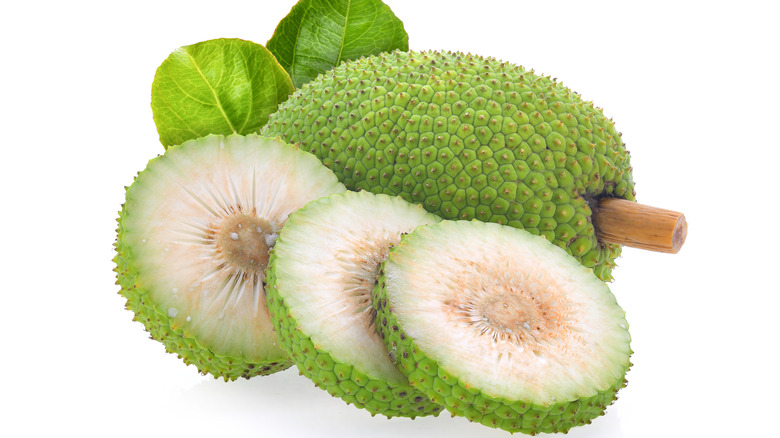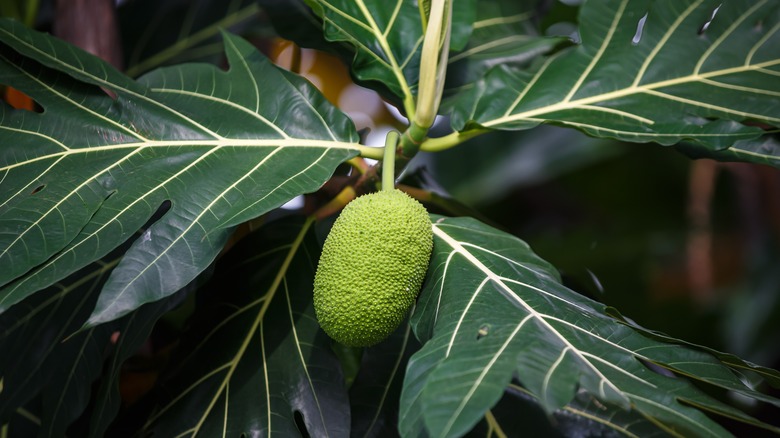Breadfruit: The Savory Fruit That Saves A Whole Lot Of Labor
If there's one thing we all know about fruit, it's that it's sweet — nature's candy! There are sour fruits too, like lemons, of course, and some other fruits can be bitter or salty under the right conditions. Did you know they can also be savory?
As it happens, one of the most popular fruits, the tomato (yes, tomatoes are fruit) is a prime example of the savory taste known as "umami," per Insider. Like bitter, salty, sour, and sweet, the umami taste is one of the five basic flavors, and it's caused by the presence of an amino acid called "glutamate." According to food scientist Pat Polowsky, savoriness is actually rather complex and there's more to it than simply glutamic acid; there are five nucleotides (DNA and RNA building blocks) responsible for the sensation, as well. Yet, even fruits that are lacking in those areas can be used in umami dishes. Even something as sugary as watermelon has sweet and savory potential.
Both tomatoes (via Modern Farmer) and watermelons (via the UC Vegetable Research & Information Center) are labor-intensive crops, though, and coincidentally, both of them grow on vines. So, when searching for savory fruits, it may be wiser to look to fruit trees, which don't take a lot of work to maintain once grown, according to Echo Community. Even in the face of changing seasons and harsh growing conditions, tree fruits continue to provide delectable and healthy food.
How to eat breadfruit
The answer to your savory-fruit needs may be breadfruit. According to Encyclopedia Britannica, this crop has long been grown in the Malay Archipelago of Southeast Asia and made its way across the tropical South Pacific during prehistory. Eventually, globalization brought it to the Americas, and it was given the English name "breadfruit" due to its starchiness and resemblance to bread when baked (via Merriam-Webster). Still to this day, breadfruit remains a staple of tropical regions like the South Pacific.
It can be eaten raw, when still noticeably sweet, per the National Tropical Botanical Garden, but it has many other, more common culinary uses. People tend to boil, grill, fry, marinate, pickle, roast, and steam breadfruit, as well as dry it out and grind it into gluten-free flour before cooking it. This fruit can also be used to make crackers, dips, or pastries, among other snacks, as well as some beverages.
Breadfruit is similar to both artichoke hearts and potatoes in flavor, and it can be used as a substitute for either one. Frying especially brings out its savory potential. Just make sure to remove the stem, wash the fruit, cut it up, take out its core, and peel off the skin when cooking it. Afterward, breadfruit can easily be put in the freezer for storage. There are several varieties of this fruit, such as ma'afala, meinpadahk, and 'ulu, per Hawaii's Department of Agriculture, but many have yet to reach the Americas from the Pacific Islands.
Breadfruit trees are easy to cultivate
Breadfruit has more to offer than just being mouthwatering. Its tree is quite an impressive sight, growing between 40 to 60 feet tall with big, shiny, green leaves atop, per Encyclopedia Britannica. Flowering produces breadfruits ranging in color from brown to green to white. The growing range may be a bit limited, due to an aversion to frost, but for warmer locales like Brazil, Mexico, and the West Indies, breadfruit trees are so easy to maintain, people grow them in gardens.
As Hawaii's Department of Agriculture explains, breadfruit trees produce plenty of fruit without needing much labor or resources from cultivators. These trees aren't picky about their plant neighbors, either, provided they get crop cover, rich soil, and some pruning. At harvest, growers keep an eye out for ripeness, drain the sap of picked fruits, and safely store the bounty afterward. This is a relative breeze compared to other work-heavy crops, and the reward is a low-fat, cholesterol-and-gluten-free fruit with lots of complex carbs. As such, this plant could improve the diets of many.
A 2022 study of breadfruit looked at its potential to combat global food insecurity as climate change, the pandemic, and wars all exacerbate world hunger (via PLOS Climate). Tropical and subtropical food systems are both at particular risk of being affected, so breadfruit's easy cultivation could prove quite the boon to places like equatorial Africa, where it's not yet widespread.
Breadfruit is not only savory; it's also super sustainable!


